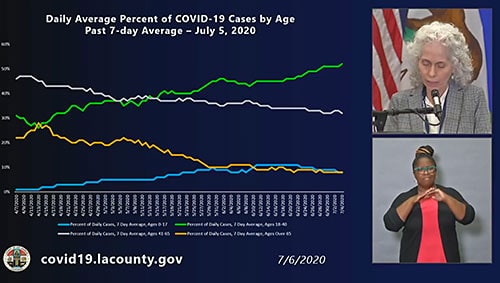Local cases keep rising; more young people infected countywide

by Steven Felschundneff | steven@claremont-courier.com
Any hopes that Los Angeles County’s recent surge of the coronavirus would subside were cast aside on Monday as public health officials reported another sharp increase in COVID-19 cases, including in the city of Claremont.
Claremont had 132 cumulative cases as of Monday afternoon which is a 14.3 percent increase over the holiday weekend and 22 percent more than a week ago. Fortunately, the confirmed number of deaths remains at two.
In its daily coronavirus update, the Los Angeles County Department of Public Health reported 7,232 new cases countywide for Thursday, Friday and Saturday, which includes 3,187 cases on Friday, the highest single day total during the pandemic.
Since its first report on March 4, public health has identified 116,570 cases of COVID-19 across all areas of LA County, and 3,534 deaths. Ninety-three percent of people who died had underlying health conditions.
In contrast to data from several months ago, almost 50 percent of new cases are among younger people, most significantly among residents between 18 and 40 years old. Those young people are in turn taking the virus home and infecting older people they know, according to health officials.
During a news conference on Monday, Director of Public Health Barbara Ferrer said that the jump in new cases has been driven by a significant drop in the number of people staying at home, an increase of people coming into close contact with others and workers returning to jobs as the economy reopens.
She also said that LA County residents have reported fewer symptoms of psychological distress related to the pandemic—slightly less worry that the outbreak poses a serious threat to personal finances and significantly less food insecurity. All three of these positive outcomes she attributed to the reopening of the local economy.
Those accomplishments, however, are threatened by the rise in new cases, increased hospitalizations and the evidence that community spread is growing. The county’s positivity rate in a seven day moving average stands at 10 percent, which is over twice what it was just a month ago. This plus the 1,921 people currently hospitalized are increasing fears that the medical system could be overrun if the trend continues.
In a series of charts presented at Monday’s news conference Ms. Ferrer showed that not only are more young people becoming infected, but they are more likely to be hospitalized than in the past.
Of the people currently hospitalized with COVID-19, about 26 percent are 18 to 40 years of age, up from 11 percent a month ago. This is also the only sector with significant increase in the number of hospitalizations, although the 0 to 17 age group is up slightly. Over that same period of time those over age 65 have dropped from over 50 percent of hospitalizations to just under 30 percent. The sector comprising the greatest number of people currently in the hospital are the 41- to 64-year-olds, but that number has remained consistent for months. Another chart showed that over the past month cases are declining or flat for every group except those between the ages of 18 and 40, which experienced an increase of about ten percentage points.
“It is clear that after months of quarantine combined with the reopening of many sectors [of the economy] we have had a lot of people disregarding the practices that have allowed us to slow the spread. Unfortunately this can not continue,” Ms Ferrer said. “Our inability to follow the most basic infection control and distancing protocols leads to serious illness, even the death of the people we love and the death of those loved by others.”
On Monday, public health confirmed 48 new deaths and 1,584 new cases of COVID-19 in the previous 24-hour period. Thirty-three people who died were over the age of 65, while 13 were between the ages of 41 and 65 years old, and one person was between 18 and 40. Forty-one people had underlying health conditions including 28 people over the age of 65.
Of those who died, information about race and ethnicity is available for 3,283 people (99 percent of the cases reported by Public Health); 44 percent of deaths occurred among Latino residents, 27 percent white, 16 percent Asian, 11 percent among Black residents, less than 1 percent among Native Hawaiian/Pacific Islander and one percent among residents identifying with other races.
“I know everyone is tired and tired of this virus. But I also know this is not forever. The sooner we all can recommit to taking care of each other the sooner we can get back to creating a new normal where we go back to work, go back to school, and we see our friends and extended family again. It’s not easy but it is straight forward. Avoid the three Cs: crowds, confined spaces and close contact,” Ms Ferrer said.










0 Comments